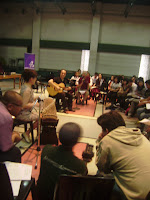 |
| Photo by Paul Louie Serrano |
If this is the
artist's way of establishing "cultural connections through music," as
they declared then Japanese musicians Aki and Kuniko certainly won the hearts
of the audience of the University of the Cordilleras (UC) theater last July 16.
Acoustic guitarist
Aki, and Koto player Kuniko performed through two standing ovations and an
encore in an hour long concert that was part of the 2012 Philippine Japan
Friendship month in Baguio City.
Supported by the
Japan Foundation which also brought to Philippine films, performances and
exhibits on the recovery of Japan's Tohoku region after March 11, 201,
"Great East Japan Earthquake." Aki and Kuniko were slated to perform
more in two venues- Manila and Cebu after their UC engagement.
Japan Foundation
Manila assistant director Mitomi Yukie explained that the inclusion of the
performances and exhibits in the aftermath of the Fukushima Earthquake in
Japan's way of extending their gratitude to the world "for its
compassionate support" to the nation and to demonstrate Japan's resolve to
rise from the disaster.
Aki and Kuniko's
July 16 performance also recalls a similar disaster that occurred in the North
Philippines including Baguio City on July 16, 1990.
But none trauma of
the both disasters was conveyed during Aki and Kunikos performance. instead the
"acoustic duos" repertoire of ten instrumental pieces brought into
focus the ethereal and gentle sound of the Koto, heard live for the first time
by some in the audience.
Commonly used in
the japanes folked music, the koto according to Yukie, is ussually played
during New Year and Spring Festivities. The instrument she said, can be played
by both genders but it is the female who is mostly seen playing music with it.
Filipinos might
recall a song crossover "Sakura" which is accompanied by Koto. Sans
vocals the main tune is essentilly delivered by the Koto. " Sakura"
is Japanese for "cherry blossom," the inspiration of the fourth song
in Aki and Kuniko's reportoire, the "flower dance".
But while the koto
delivers "delicate heartrending murmurs" when plyed by itself, the
instruments range widens and becomes driving and forceful when matched with an
acoustic guitar.
According to Aki
and Kuniko, the acoustic guitar and the koto are natural blend. "The
instruments do not accompany each other but rather they are
complementary."
In the next days workshop attended by the Uc Percussion and
orchestra, The UC Hapiyoh cultural groups and Students from Baguio City
National High School, both musicians elaborated in their instruments are
complementary.
“ There is a dominant and passive dynamic to our music,”
they said alluding to the concept of balance and harmony Yin and Yang. “The guitar adjusts with the fixed structure
of the Koto,” they explain.
 The koto’s fixed structure is the result of the tuning
system where the bridge for each of its thirteen strings is provided. Tone is
assigned by positioning the bridge nearer or farther from the string catch for
higher and lower tones. Unlike the guitar, the Koto has no tuning Pegs.
The koto’s fixed structure is the result of the tuning
system where the bridge for each of its thirteen strings is provided. Tone is
assigned by positioning the bridge nearer or farther from the string catch for
higher and lower tones. Unlike the guitar, the Koto has no tuning Pegs.
Uc Percussion and Orchestra conductor Paul Louie Serrano
observed that Koto is tuned in octaves, which is set apart from the standard
tuning of the Acoustic Guitar. Aki acknowledges that he must indeed detune his
acousticguitar – adding one whole step from the lower A and D strings and
subtracting one whole step from the higher N and E strings to match the Koto’s
tuning system.
This results in a guitar chord pattern that matches the
musicality of the Koto. Yukie explaines that Aki and Kuniko musical
collaboration consict of original compositions inspired by traditional
classical and contemporary music. Chording with the acoustic guitar unifies the
sound of the Koto where it is played with the single note picking.
However the dynamic of the guitar also shows when Aki plays
scales and it is Kuniko’s turn to blend. Aki says he generally plays the E
minor pentatonic which is blues and jazz driven. Koto players , explaines
Kuniko, optimizesthe instruments range through different techniques in drawing
the sound. These consist on plucking the low, middle and high tones, blending,
blending, sweeping and scratching the strings.
 For the workshop participants, the upclose encounter with
the Koto was an experience. “for now, let us forget Hip-hop, rap and rock
music. Let us indulge with learning first,” one participant said.
For the workshop participants, the upclose encounter with
the Koto was an experience. “for now, let us forget Hip-hop, rap and rock
music. Let us indulge with learning first,” one participant said.
The instrument which was originated from China, is made of
hollowed Paulonia wood known in Japan as Kiri. Kuniko explains the design and
pattern of the Koto’s body is that of dragon’s. While the bridge and strings
were traditionally made out of Ivory and Silk, today they are made of synthetic
materials.
“But the care and attention devoted to the instrument is still traditional,”
Kuniko said. “ There is a specialist dedicated to fixing strings, another
specialist tunes it.”
Source: Baguio Midland Courier
No comments:
Post a Comment